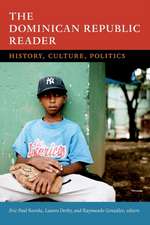Cumbia! – Scenes of a Migrant Latin American Music Genre
Autor Héctor Fernández L`hoe, Pablo Vilaen Limba Engleză Paperback – 28 mai 2013
Preț: 264.26 lei
Nou
Puncte Express: 396
Preț estimativ în valută:
50.57€ • 54.07$ • 42.16£
50.57€ • 54.07$ • 42.16£
Carte tipărită la comandă
Livrare economică 17 aprilie-01 mai
Preluare comenzi: 021 569.72.76
Specificații
ISBN-13: 9780822354338
ISBN-10: 0822354330
Pagini: 312
Ilustrații: 13 illustrations, 1 map, 6 figures
Dimensiuni: 153 x 241 x 23 mm
Greutate: 0.45 kg
Editura: MD – Duke University Press
ISBN-10: 0822354330
Pagini: 312
Ilustrații: 13 illustrations, 1 map, 6 figures
Dimensiuni: 153 x 241 x 23 mm
Greutate: 0.45 kg
Editura: MD – Duke University Press
Cuprins
Acknowledgments ix
Introduction / Héctor Fernández L'Hoeste and Pablo Vila 1
1. Cumbia Music in Colombia: Origins, Transformations, and Evolution of a Coastal Music Genre / Leonardo D'Amico 29
2. ¿Pa' dónde vas Marioneta? ¿Pa' dónde va la gaita?: La Cumbiamba Eneyé Returns to San Jacinto / Jorge Arévalo Mateus with Martín Vejarano 49
3. Cumbia in Mexico's Northeastern Region / José Juan Olvera Gudiño 87
4. Rigo Tovar, Cumbia, and the Transnational Grupero Boom / Alejandro L. Madrid 105
5. Communicating the Collective Imagination: The Sociospatial World of the Mexican Sonidero in Puebla, New York and New Jersey / Cathy Ragland 119
6. From The World of the Poor to the Beaches of Eisha:, Cumbia, and the Search for a Popular Subject in Peru / Joshua Tucker 138
7. Pandillar in the Jungle: Regionalism and Tecno-cumbia in Amazonian Peru / Kathryn Metz 168
8. Gender Tensions in Cumbia Villera's Lyrics / Pablo Semán and Pablo Vila 188
9. Feliz, feliz / Cristian Alarcón 213
10. El "Tú" Tropical, el "Vos" Villero, and Places in Between: Language, Ideology, Music, and the Spatialization of Difference in Uruguayan Tropical Music / Matthew J. Van Hoose 226
11. On Music and Colombianness: Toward a Critique of the History of Cumbia / Héctor Fernández L'Hoeste 248
References 269
Contributors 285
Index 289
Introduction / Héctor Fernández L'Hoeste and Pablo Vila 1
1. Cumbia Music in Colombia: Origins, Transformations, and Evolution of a Coastal Music Genre / Leonardo D'Amico 29
2. ¿Pa' dónde vas Marioneta? ¿Pa' dónde va la gaita?: La Cumbiamba Eneyé Returns to San Jacinto / Jorge Arévalo Mateus with Martín Vejarano 49
3. Cumbia in Mexico's Northeastern Region / José Juan Olvera Gudiño 87
4. Rigo Tovar, Cumbia, and the Transnational Grupero Boom / Alejandro L. Madrid 105
5. Communicating the Collective Imagination: The Sociospatial World of the Mexican Sonidero in Puebla, New York and New Jersey / Cathy Ragland 119
6. From The World of the Poor to the Beaches of Eisha:
7. Pandillar in the Jungle: Regionalism and Tecno-cumbia in Amazonian Peru / Kathryn Metz 168
8. Gender Tensions in Cumbia Villera's Lyrics / Pablo Semán and Pablo Vila 188
9. Feliz, feliz / Cristian Alarcón 213
10. El "Tú" Tropical, el "Vos" Villero, and Places in Between: Language, Ideology, Music, and the Spatialization of Difference in Uruguayan Tropical Music / Matthew J. Van Hoose 226
11. On Music and Colombianness: Toward a Critique of the History of Cumbia / Héctor Fernández L'Hoeste 248
References 269
Contributors 285
Index 289
Recenzii
"Cumbia has mattered, matters, and will most likely continue to matter for the multitudes who create it, listen and dance to it, and debate it almost as a way of life. This collection is both a sonic roadmap and testimony to the imagination of people across the Americas as they make some sense of their many worlds through music."Jairo Moreno,author of Musical Representations, Subjects, and Objects"This is a significant, comprehensive, and timely collection of essays. As the essays demonstrate, cumbia is probably the most widespread rhythm in the Americas. Yet, until now, its travels and transformations have not received systematic attention, taking into account the complexities of the genre's roots in northern coastal Colombia and its subsequent routes into Mexico, Peru, Argentina, and the United States. Cumbia! fills a crucial gap in the literature on Latin/o American popular music."George Yudice,author of The Expediency of Culture: Uses of Culture in the Global Era
Notă biografică
Descriere
The contributors to Cumbia! look at particular manifestations of cumbia through their disciplinary lenses of musicology, sociology, history, anthropology, linguistics, and literary criticism.









